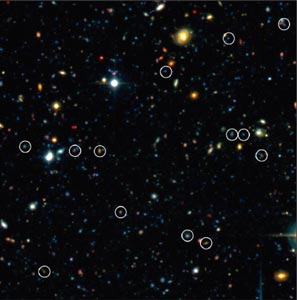A team using the Very Large Telescope (VLT) of the European Southern Observatory (ESO) has identified a much larger population of distant galaxies than previously estimated. The new population mainly consists of galaxies forming stars at a very high rate.

The determination of the number of galaxies in the universe at different epochs is crucial for constraining models of the formation and evolution of galaxies. Counting galaxies in deep astronomical images is relatively simple, but measuring their redshift – hence, their distance and the epoch in the history of the universe when we see them – requires taking a spectrum of each galaxy.
Until now, measuring the spectrum of distant and therefore faint galaxies needed a great deal of observing time on the largest telescopes. Astronomers therefore had to select carefully the candidate high-redshift galaxies based on their brightness and colour. However, it now seems that they have been too restrictive in their criteria, thus missing a large population of distant galaxies with strong ultraviolet emission.
The discovery of this population of bright and distant galaxies was made possible by the Visible Multi-Object Spectrograph (VIMOS) on Melipal, one of the four 8.2 m telescopes of the VLT. Instead of measuring the spectrum of one galaxy at a time, VIMOS can measure simultaneously the spectra of about 1000 galaxies in a single field.
The unique capabilities of VIMOS allowed a team of French and Italian astronomers to determine systematically the redshift of all the galaxies in a given sky area and a given range of brightness. From a total of about 8000 galaxies, almost 1000 were measured at a redshift between 1.4 and 5, corresponding to looking back 9-12 billion years.
The results published by O Le Fèvre and collaborators show that the number density of galaxies at a redshift of around 3 exceeds previous estimates by a factor of 1.6 for the faintest galaxies and of 6.2 for the brightest ones. Around a redshift of 4 the number of galaxies was underestimated by a factor of 2-3.5. It seems therefore that a large population of bright galaxies at high-redshift was completely overlooked.
The newly identified population escaped previous studies mainly because of relatively high ultraviolet emission, which is emitted by massive young stars. The ultraviolet luminosity of these galaxies allows the estimate that their star-formation rate is in the region of 10-100 solar masses per year; currently in the Milky Way only a few solar masses of gas and dust are converted into stars every year. This discovery has profound implications for the history of star formation in the universe and for current theories of the formation and evolution of galaxies.
Further reading
O Le Fèvre et al. 2005 Nature 437 519.








